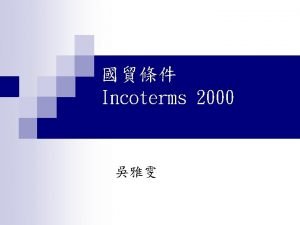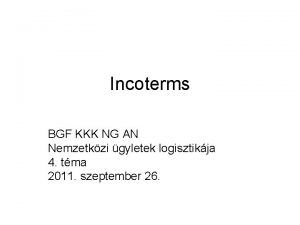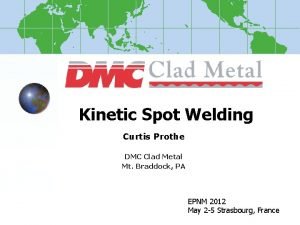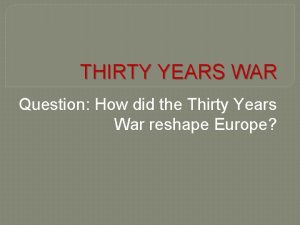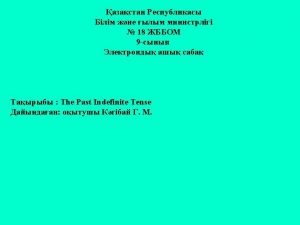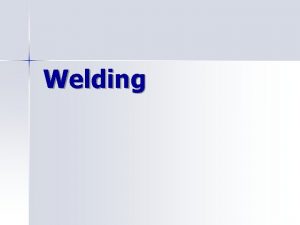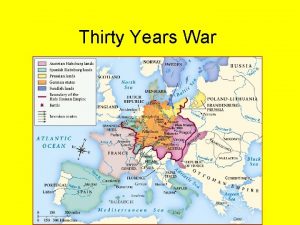LECTURE THIRTY Explosion Welding Explosion welding EXW is








- Slides: 8

LECTURE THIRTY Explosion Welding

Explosion welding (EXW) is a solid-state welding process in which rapid coalescence of two metallic surfaces is caused by the energy of a detonated explosive. It is commonly used to bond two dissimilar metals, in particular to clad one metal on top of a base metal over large areas. Applications include production of corrosionresistant sheet and plate stock for making processing equipment in the chemical and petroleum industries. The term explosion cladding is used in this context. No filler metal is used in EXW, and no external heat is applied. Also, no diffusion occurs during the process (the time is too short). The nature of the bond is metallurgical, in many cases combined with a mechanical interlocking that results from a rippled or wavy interface between the metals.

The process for cladding one metal plate on another can be described with reference to Figure 30. 1. In this setup, the two plates are in a parallel configuration, separated by a certain gap distance, with the explosive charge above the upper plate, called the flyer plate. A buffer layer (e. g. , rubber, plastic) is often used between the explosive and the flyer plate to protect its surface. The lower plate, called the backer metal, rests on an anvil for support. When detonation is initiated, the explosive charge propagates from one end of the flyer plate to the other, caught in the stop-action view shown in Figure 30. 1(2). One of the difficulties in comprehending what happens in EXW is the common misconception that an explosion occurs instantaneously; it is actually a progressive reaction, although admittedly very rapid—propagating at rates as high as 8500 m/s (28, 000 ft/sec).

FIGURE 30. 1

The resulting high-pressure zone propels the flyer plate to collide with the backer metal progressively at high velocity, so that it takes on an angular shape as the explosion advances, as illustrated in our sketch. The upper plate remains in position in the region where the explosive has not yet detonated. The high-speed collision, occurring in a progressive and angular fashion as it does, causes the surfaces at the point of contact to become fluid, and any surface films are expelled forward from the apex of the angle. The colliding surfaces are thus chemically clean, and the fluid behavior of the metal, which involves some interfacial melting, provides intimate contact between the surfaces, leading to metallurgical bonding. Variations in collision velocity and impact angle during the process can result in a wavy or rippled interface between the two metals. This kind of interface strengthens the bond because it increases the contact area and tends to mechanically interlock the two surfaces.

Explosion Welding Attributes Metallurgical Attributes. Because of the absence of heating, EXW products do not exhibit many of the metallurgical characteristics of fusion-welded, brazed, or hot-rolled/forged products. Unlike those processes, in EXW. 1. The component metals remain in their wrought states. 2. The microstructure, mechanical properties, and corrosion properties of parent metals are not altered. 3. There are no heat –affected zones. 4. There is almost no diffusion of alloying elements between components.

The Advantage Of Explosion Welding It is used to bond dissimilar metals No filler metal is used in explosion welding process The process is simple , rapid and gives a close thickness tolerances Multiple layers can be bonded in s single bonding operation Two sides clad plates , with a heavy core metal, can be produced in same time using vertical assembly Two or more cylinders can be bonded concentrically the explosive is placed either inside or outside depending on diameter and wall thickness

The limitations of the explosion welding process Size Limitations. Explosion welding is appropriate for use over a broad range of sizes. It has been used for joining electronic components of widths less than 0. 5 mm (0. 020 in. ) and for cladding plates up to 5 × 13 m (16 × 40 ft). Cladding metal thicknesses can range from 0. 025 to 100 mm (0. 001 to 4 in. ), and base metal thickness can range from 0. 025 mm (0. 001 in. ) to over 1 m (40 in. ). The size limits are generally mandated by component metal manufacturability and transport requirements. Configuration Limitations. Explosion welding is limited to the bonding of flat surfaces or coaxial cylindrical surfaces. It is ideally suited for bonding large, flat areas, as in clad plate manufacture. Low melting point and low impact resistance materials cannot welded by this process effectively. The process is dangerous.
